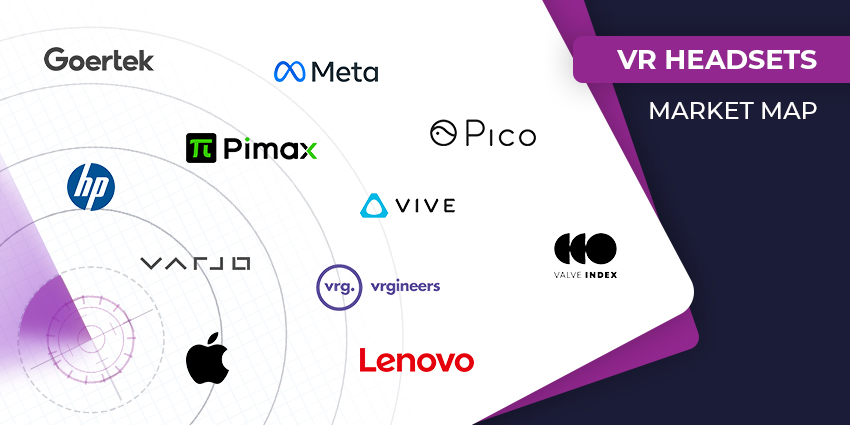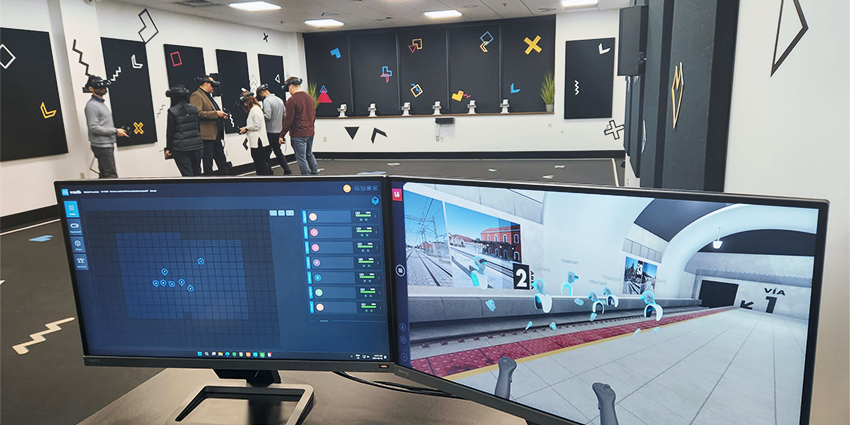In the last few years, there’s been less hype around VR gloves and haptic accessories in the extended reality space. However, as the adoption of virtual reality grows in the business landscape for training, product development, and collaboration, this is beginning to change.
While the average consumer might not need haptic experiences in VR games, sensory feedback in the business world can be extremely valuable. It’s an excellent way to increase muscle memory in VR training and improve user experience. This might be part of the reason why the haptic technology market is expected to reach a value of $5 billion by 2028.
If you’re embracing the industrial metaverse or unlocking the benefits of extended reality in the enterprise during 2024, VR gloves could be a great investment. Here’s everything you need to know about VR gloves, how they work, and the options available on the market today.
What are VR Gloves and How Do They Work?
VR gloves are a wearable XR accessory designed to enhance immersion with spatial computing capabilities and sensory feedback. These gloves are fitted with technology that delivers various forms of feedback to users wearing an extended reality headset.
Haptic gloves utilize various cutting-edge technologies to deliver sensory feedback that aligns with the content you see on a VR headset screen. Their functionality and components vary depending on the type of feedback they provide. For instance, force feedback emulates the feeling of object size and density in VR through the use of magnetic friction brakes built into a glove.
Vibrotactile feedback enables other gloves to simulate the feeling of things like touching a surface or clicking a button using actuators in the fingers of the glove. Some solutions even use hundreds of microfluidic actuators to interact with your skin so you can feel different sensations.
Different kinds of gloves can:
- Track the position of your hands more accurately in a virtual space
- Provide vibrotactile feedback, simulating the texture of virtual objects
- Use force feedback to convey the size and density of objects
- Leverage contact feedback to convey the shape of objects and surfaces
- Use temperature to deepen virtual immersion
Over the years, numerous types of VR gloves have emerged, thanks to the innovation of market-leading vendors. Even Meta acquired a haptic startup to start developing their own VR gloves a few years ago. Although the project was put on hold, the new “Haptics Studio” created by Meta in 2023 indicates the company is again stepping into the haptic landscape.
What are VR Gloves Used for? Use Cases and Opportunities
Right now, VR gloves and haptic technologies aren’t particularly commonplace. Although countless business leaders are investing in extended reality and the metaverse, few have explored the benefits of VR gloves. However, haptic technologies have the potential to support various use cases.
They’re not just ideal for intelligent gaming and entertainment. Haptic and metaverse gloves can be fantastic for business settings, too. In the corporate landscape, haptic gloves can offer a more immersive experience to users working on prototypes for new products in the virtual world.
VR gloves are excellent for elevating training experiences in industries like healthcare and many others. They can give surgeons a realistic experience of interacting with body parts or tools, creating muscle memory, and increasing knowledge retention.
Haptic gloves are also excellent for improving the accuracy of specific actions in virtual reality. Their sensors and gesture-tracking capabilities allow designers to create unique landscapes or enable users to interact with smaller assets with excellent precision. These tools can even support rehabilitation and therapy, assisting patients in recovering or improving motor skills.
What to Look for in VR Gloves
Numerous factors are worth considering when investing in VR accessories. The products you purchase for your team usually depend on your budget, use cases, and other priorities, like comfort and compatibility.
Here are some of the main points to look at when you’re narrowing down your options:
- Feedback options: Haptic gloves use actuators and other technologies to simulate various forms of sensory feedback. Depending on their design, they can convey pressure (or force), texture, temperature, and more.
- Sensors: Advanced sensors in haptic gloves are excellent for detecting the movement of fingers for spatial computing. High-quality sensors make it easier for users to interact with digital content and improve the user experience.
- Gesture recognition: Some haptic gloves can work alongside artificial intelligence and machine learning algorithms. This allows them to recognize specific patterns of movement and hand gestures, making it easier to control virtual interfaces.
- Comfort: Unlike traditional gloves, VR gloves aren’t one-size-fits-all. Most companies design these gloves to be adjustable and comfortable for all users. They often feature breathable materials and lightweight components.
- Wireless connectivity: Most VR gloves will feature wireless connectivity solutions, which allow them to interact with virtual reality headsets. This eliminates the need for cumbersome wires so that you can move more freely in VR.
The Top VR Gloves to Consider in 2024
As mentioned above, the number of companies investing in haptic technologies is still relatively small. However, the interest in VR gloves and similar solutions is increasing. Meta appears to be re-focusing its attention on haptic solutions with its Reality Labs department. New startups are constantly emerging in the XR market, introducing new haptic experiences.
Here are some top VR gloves you can consider in 2024.
1. SenseGlove Nova 2
SenseGlove is a pioneer in the haptic and VR gloves landscape. Following the success of its original haptic glove, the “Nova,” the SenseGlove Nova 2 was released in 2023. This comfortable glove system uses active contact feedback to simulate sensory experiences when users interact with VR content. The gloves are some of the most convenient and compact wireless options available.
With the SenseGlove Nova 2 VR gloves, users get everything from force feedback to vibrotactile feedback in one convenient kit. There’s even state-of-the-art finger tracking to help enhance accuracy and precision in virtual reality scenarios. These gloves are also compatible with HTC VIVE, Meta Quest, and Pico Neo headsets, offering excellent versatility.
2. HaptX Gloves G1
Another innovator in the VR gloves sector, HaptX, offers comprehensive haptic solutions specifically designed for business use cases. Their gloves are a little more advanced than some of the other options you’ll see on the market today, covering not just your fingers but your wrists and forearms. You can see a great example of what they look like in this demonstration from Jeff Bezos.
Available in various sizes, the HaptX G1 gloves include 135 tactile actuators per glove and 9 PSI peak pressure. Despite their complex design, they’re also highly lightweight, ensuring you can still access an excellent comfort level. As a bonus, you get built-in position and movement tracking to ensure accurate interactions.
3. Manus Prime Mocap Metagloves
If you’re looking for haptic gloves perfect for creating metaverse and VR content, Manus Prime’s Mocap Metagloves are a great solution. Designed more for granular gesture tracking than sensory stimulation, these gloves feature quantum-tracking technology with fingertip-tracking sensors.
They’re excellent for capturing and recording detailed hand movements for XR game and app development. There’s even zero-loss on-body recording at 120 FPS. Plus, the gloves are compatible with various software platforms, such as Unity and Unreal Engine. If you want a more sensory experience, check out the Manus Prime 3 haptic gloves, with force feedback.
4. TeslaSuit VR Gloves
If you’ve been researching haptic feedback for a while, you’re probably familiar with the “TeslaSuit” team. The company is a pioneer in XR wearables, with full haptic suits designed for various use cases. They also offer the “Teslaglove,” featuring force and haptic feedback, finger tracking, and biometrics.
These intuitive gloves have a lightweight design, forming an exoskeleton around the hand of the user. With 45 channels for haptic feedback per glove, they can deliver a truly unique experience for users. These gloves are handy for motion capture purposes in VR content creation. Plus, they work alongside Meta Quest controllers and HTC VIVE trackers.
5. bHaptics TactGlove
Presented as the world’s first consumer-ready VR gloves, the TactGlove wearables from bHaptics are sleek, stylish, and convenient. They come with their unique neuromorphic algorithm to enable natural and realistic haptic feedback in virtual reality settings. Plus, they’re compatible with top VR headsets, such as the Meta Quest and Pico Neo.
Available in various sizes, these gloves are incredibly comfortable and have an internal washable section to maintain hygiene. They’re also completely wireless, thanks to advanced Bluetooth connectivity. Moreover, these VR gloves offer up to 3.5 hours of battery life, making them ideal for lengthy VR sessions.
6. Fluid Reality Haptic Gloves
Though Fluid Reality has yet to release its VR gloves at the time of writing, they’re already promising consumers an incredible experience. The company developed a first-of-its-kind glove in 2023 with 160 dynamic haptic feedback actuators for high-resolution touch experiences. Inside the glove are numerous high-res finger pad arrays for every fingertip.
These arrays are essentially like displays for your skin, imprinting tactile images onto your fingers as you interact with virtual content. The system promises to be compact, lightweight, and comfortable, suitable for many users. Plus, they don’t need to be connected to any devices via wires.
Are VR Gloves Better than Controllers?
While VR gloves could be a revolutionary accessory for today’s XR-focused companies, they’re not necessary for every business. VR controllers are becoming more ergonomic and advanced. Plus, some extended reality innovators are creating headsets with spatial computing capabilities, eliminating the need for controllers and gloves to provide detailed information to software.
However, there are benefits to using haptic gloves instead of controllers that go beyond higher precision and accuracy when interacting with VR content. Primarily, VR gloves:
- Enhanced interactivity: Haptic gloves allow users to interact with virtual objects using their hands and fingers, allowing for a more natural experience. Using controllers can sometimes reduce the overall sense of immersion. Some spatial computing solutions aren’t as effective at tracking precise movements as VR gloves.
- Unique experiences: VR gloves deliver a deeper immersion through tactile feedback. They allow users to feel like they’re touching, grasping, or interacting with virtual objects. This increases the level of realism in a virtual reality environment and can improve the quality of training sessions.
- Versatility: The increased accuracy and precision offered by metaverse gloves can make it easier to leverage a broader range of tools and apps in virtual reality. It’s much easier to design comprehensive prototypes and create virtual reality content when your software can track the intricate movements of your fingers and knuckles.
Stepping into the Future with VR Gloves
Currently, VR gloves have yet to enter the mainstream. Many companies investing in extended reality still aren’t using haptic technologies. However, demand could grow as innovators continue to enter the market, creating gloves with better feedback experiences, improved tracking, and greater ergonomics. As businesses continue to rely on XR technologies for training, collaboration, development, and various other processes, haptic gloves offer many benefits.
Additionally, continued investment in the metaverse and XR technologies could mean we begin to see more affordable VR gloves in the market, increasing accessibility for all kinds of brands.
FAQ
Are VR Gloves good?
VR gloves can offer a range of unique benefits to users. They’re excellent for improving the precision and accuracy of employees leveraging complex VR applications. They also provide deeper immersion and enhanced user experiences in the metaverse.
How do VR gloves work?
VR gloves utilize various technologies, such as sensors and actuators, to track the movements of your fingers and deliver sensory feedback. Different VR gloves have unique capabilities; some even leverage AI and machine learning for gesture recognition.
Is there such a thing as VR gloves?
While VR gloves aren’t as popular as some other accessories in the XR space today, demand for these solutions is beginning to grow. As companies continue to adopt VR headsets for various use cases, the number of VR glove solutions will increase.







